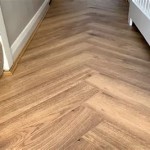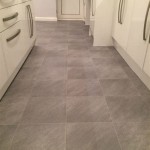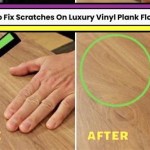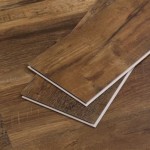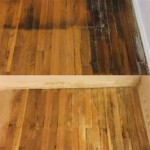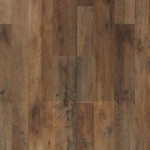Is Vinyl Plank Flooring Toxic? Unveiling Potential Concerns
Vinyl plank flooring has surged in popularity as a cost-effective, durable, and aesthetically versatile alternative to traditional flooring options like hardwood, tile, and laminate. Its water resistance, ease of installation, and diverse design options make it an attractive choice for homeowners and businesses alike. However, concerns have been raised regarding the potential toxicity of vinyl plank flooring and its impact on indoor air quality. Understanding the composition of vinyl plank flooring and the potential health risks associated with its various components is crucial for informed decision-making.
The term "vinyl plank flooring" encompasses a range of products, each with varying compositions and manufacturing processes. Generally, vinyl plank flooring consists of several layers, including a wear layer, a decorative layer, and a core layer. The wear layer, typically made of polyurethane or a similar protective coating, provides resistance to scratches and stains. The decorative layer displays the printed image that mimics wood, stone, or other desired patterns. The core layer, which provides stability and support, is primarily composed of polyvinyl chloride (PVC). In some products, the core may also include recycled materials, fillers, and plasticizers.
PVC, the primary component of many vinyl plank flooring products, is a synthetic plastic polymer known for its durability and water resistance. However, the production and use of PVC have been linked to environmental and health concerns. During the manufacturing process, chlorine, a key ingredient in PVC, can generate harmful byproducts, including dioxins, which are persistent organic pollutants known to accumulate in the environment and human tissues. Moreover, the improper disposal of PVC can also lead to the release of these toxins into the environment.
In addition to PVC, vinyl plank flooring often contains plasticizers, which are chemicals added to make the PVC more flexible and pliable. Phthalates are a common type of plasticizer used in vinyl flooring. Some phthalates have been linked to adverse health effects, including endocrine disruption, reproductive toxicity, and developmental problems. While regulations have restricted the use of certain phthalates in children's products, their presence in vinyl flooring remains a concern for some consumers.
Another potential source of concern is the emission of volatile organic compounds (VOCs) from vinyl plank flooring. VOCs are organic chemicals that evaporate at room temperature and can contribute to indoor air pollution. Some VOCs, such as formaldehyde, benzene, and toluene, are known to be harmful to human health. Exposure to high levels of VOCs can cause a range of symptoms, including headaches, dizziness, eye irritation, and respiratory problems. The amount of VOCs emitted from vinyl plank flooring can vary depending on the product's composition, manufacturing process, and age.
Several factors influence the potential toxicity of vinyl plank flooring. One key factor is the quality of the materials used in its production. High-quality vinyl plank flooring products are typically manufactured with stricter quality control measures and may contain lower levels of harmful chemicals. Another factor is the manufacturing process. Environmentally conscious manufacturers employ processes that minimize the release of pollutants and reduce the use of hazardous materials. The age of the flooring can also affect its toxicity. Newly installed vinyl plank flooring may emit higher levels of VOCs than older flooring that has had time to off-gas.
Choosing Low-VOC Vinyl Plank Flooring
Selecting low-VOC vinyl plank flooring is a proactive step towards mitigating potential health risks associated with indoor air quality. Several certifications and labels can assist consumers in identifying products that meet specific emission standards. The FloorScore certification, for example, indicates that a product has been tested and meets stringent VOC emission limits. The Greenguard Gold certification is another widely recognized standard that ensures low chemical emissions, making it suitable for sensitive environments like schools and healthcare facilities. These certifications often use testing methods that conform to California Department of Public Health (CDPH) Standard Method v1.2, a rigorous testing protocol for VOC emissions from building materials.
When searching for low-VOC vinyl plank flooring, consumers should carefully examine product specifications and certifications. Reputable manufacturers typically provide detailed information about the materials used in their products and their compliance with relevant environmental standards. It is advisable to request third-party testing data to verify the manufacturer's claims regarding VOC emissions. Paying attention to the product’s Material Safety Data Sheet (MSDS) or Safety Data Sheet (SDS) provides detailed information on the composition and potential hazards of the material.
Beyond certifications, consider the materials used in the flooring’s construction. Look for products labeled as phthalate-free or those using bio-based plasticizers. These alternatives aim to reduce the potential for endocrine disruption and other health concerns associated with traditional phthalates. Recycled content can also be a positive attribute, indicating a commitment to resource conservation and potentially lower reliance on virgin PVC.
Mitigation Strategies During and After Installation
Even with low-VOC vinyl plank flooring, implementing mitigation strategies during and after installation can further minimize potential exposure to harmful chemicals. Proper ventilation is paramount during the installation process. Opening windows and doors allows for the dissipation of any VOCs released during the unboxing and laying of the flooring. Consider using fans to enhance air circulation and expedite the off-gassing process.
Before installation, consider unrolling the vinyl planks in a well-ventilated area for a few days. This practice, known as pre-conditioning or airing out, allows some of the initial VOCs to dissipate before the flooring is installed. While this might require some space and planning, it can significantly reduce the indoor air burden once the flooring is in place.
After installation, continue to prioritize ventilation. регулярно проветривайте помещения, особенно в первые несколько недель. Regular cleaning with mild, non-toxic cleaning products can also help to remove any residual chemicals that may have settled on the flooring surface. Avoid using harsh cleaning agents or solvents that could potentially react with the vinyl and release additional VOCs.
Long-term mitigation strategies also involve maintaining a healthy indoor environment. Using air purifiers equipped with activated carbon filters can help to remove VOCs from the air. Maintaining proper humidity levels can also prevent the growth of mold and mildew, which can exacerbate indoor air quality problems. Regularly inspecting and cleaning the flooring can prevent the accumulation of dust and allergens that can contribute to respiratory issues.
Exploring Alternative Flooring Options
For individuals highly sensitive to chemicals or particularly concerned about the potential health risks associated with vinyl plank flooring, exploring alternative flooring options is a prudent approach. Several alternatives offer comparable durability and aesthetic appeal while minimizing exposure to VOCs and other potentially harmful substances. These alternatives often embrace sustainable materials and manufacturing processes, aligning with a broader commitment to environmental and human health.
Linoleum flooring is a natural and sustainable alternative made from renewable materials such as linseed oil, rosin, wood flour, and cork dust. It is naturally antibacterial, biodegradable, and emits very low levels of VOCs. While it may require professional installation, linoleum offers excellent durability and a wide range of colors and patterns.
Another option is engineered hardwood flooring, which consists of a thin layer of hardwood veneer bonded to a core of plywood or high-density fiberboard (HDF). Look for engineered hardwood products certified by FloorScore or Greenguard Gold to ensure low VOC emissions. Bamboo flooring is also a sustainable and durable alternative made from rapidly renewable bamboo grass. Choose strand-woven bamboo for enhanced strength and resistance to wear and tear.
Tile flooring, including ceramic, porcelain, and stone tiles, is another low-VOC option that is naturally resistant to moisture and mold. While tile can be more expensive than vinyl plank flooring, it offers exceptional durability and longevity. Ensure that the grout used to install the tile is also low-VOC to minimize potential off-gassing during and after installation.
Ultimately, the decision of whether or not to use vinyl plank flooring involves weighing the potential benefits against the potential risks. By understanding the composition of vinyl plank flooring, the factors that influence its toxicity, and the available mitigation strategies, consumers can make informed choices that prioritize their health and well-being. Choosing certified low-VOC products, implementing proper installation practices, and maintaining a healthy indoor environment can significantly reduce the potential risks associated with vinyl plank flooring. Furthermore, exploring alternative flooring options provides additional avenues for minimizing exposure to harmful chemicals and creating a healthier living space.

The Dangers Of Luxury Vinyl Floors Lvt And How You Can Avoid Them Artisan Wood Llc

Are Vinyl Floors Toxic Olde Tyme Floor

Biggest Advantages Disadvantages Of Vinyl Plank Flooring

Are Vinyl Floors Toxic Olde Tyme Floor

Unbiased Luxury Vinyl Plank Flooring Review Cutesy Crafts

The Dangers Of Luxury Vinyl Floors Lvt And How You Can Avoid Them Artisan Wood Llc

Is Vinyl Flooring Harmful To Health Singapore Laminate

6 Vinyl Flooring Myths Get The Facts From Our Experts Inc

Vinyl Vs Hybrid Flooring Which Is Better For You

The Ultimate Guide To Non Toxic Flooring Atkinson Kirby
Related Posts

